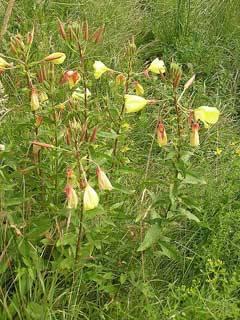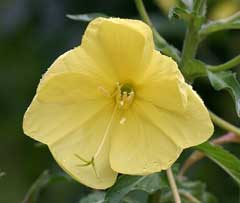 |
|
http://commons.wikimedia.org/wiki/User:Mbc |
 |
| http://commons.wikimedia.org/wiki/User:Paethon |
Translate this page:
Summary
Physical Characteristics

 Oenothera glazioviana is a BIENNIAL growing to 1.5 m (5ft).
Oenothera glazioviana is a BIENNIAL growing to 1.5 m (5ft).
See above for USDA hardiness. It is hardy to UK zone 3 and is not frost tender. It is in flower from July to October, and the seeds ripen from August to October. The species is hermaphrodite (has both male and female organs) and is pollinated by Lepidoptera (Moths & Butterflies), bees. The plant is self-fertile.
It is noted for attracting wildlife.
Suitable for: light (sandy) and medium (loamy) soils and prefers well-drained soil. Suitable pH: mildly acid, neutral and basic (mildly alkaline) soils. It cannot grow in the shade. It prefers dry or moist soil.
UK Hardiness Map
US Hardiness Map
Synonyms
O. erythrosepala. Borbas. O. lamarkiana. DeVries. non Ser.
Plant Habitats
Cultivated Beds;
Edible Uses
Edible Parts: Leaves Oil Root Shoots
Edible Uses: Oil
Root - cooked. Boiled and eaten like salsify[144]. Fleshy and succulent. Young shoots - raw or cooked[144]. Mild and inoffensive[144] Seed contains 28% of a drying oil[114]. It is edible and a very good source of gammalinolenic acid[141], an essential fatty acid that is not found in many plant sources and has numerous vital functions in the body. Difficult to harvest, it has to be done by hand[160].
References More on Edible Uses
Medicinal Uses
Plants For A Future can not take any responsibility for any adverse effects from the use of plants. Always seek advice from a professional before using a plant medicinally.
Anticholesterolemic Astringent Hypotensive Miscellany Sedative
The oil in the seeds is anticholesterolemic, astringent, hypotensive, sedative[4, 21]. Reduces cholesterol levels[66]. Research suggests that the oil is potentially very valuable in the treatment of multiple sclerosis, pre-menstrual tension, hyperactivity etc[66].
References More on Medicinal Uses
The Bookshop: Edible Plant Books
Our Latest books on Perennial Plants For Food Forests and Permaculture Gardens in paperback or digital formats.

Edible Tropical Plants
Food Forest Plants for Hotter Conditions: 250+ Plants For Tropical Food Forests & Permaculture Gardens.
More

Edible Temperate Plants
Plants for Your Food Forest: 500 Plants for Temperate Food Forests & Permaculture Gardens.
More

More Books
PFAF have eight books available in paperback and digital formats. Browse the shop for more information.
Shop Now
Other Uses
References More on Other Uses
Cultivation details
Prefers a dryish well-drained sandy loam and full sun[1, 200]. Heavy clay soils may induce winter rots[200]. Succeeds on poor soils[200]. The flowers open in the evening, they are richly scented and are very attractive to moths[4]. The seeds are a good food source for birds, especially finches[200]. The plants of this species are of hybrid origin and usually mutate freely[1]. Usually self-sows freely if in a suitable position[K].
References Carbon Farming Information and Carbon Sequestration Information
Temperature Converter
Type a value in the Celsius field to convert the value to Fahrenheit:
Fahrenheit:
The PFAF Bookshop
Plants For A Future have a number of books available in paperback and digital form. Book titles include Edible Plants, Edible Perennials, Edible Trees,Edible Shrubs, Woodland Gardening, and Temperate Food Forest Plants. Our new book is Food Forest Plants For Hotter Conditions (Tropical and Sub-Tropical).
Shop Now
Plant Propagation
Seed - sow in situ from late spring to early summer.
Other Names
If available other names are mentioned here
Native Range
Coming Soon
Weed Potential
Right plant wrong place. We are currently updating this section.
Please note that a plant may be invasive in one area but may not in your area so it's worth checking.
Conservation Status
IUCN Red List of Threatened Plants Status :

Growth: S = slow M = medium F = fast. Soil: L = light (sandy) M = medium H = heavy (clay). pH: A = acid N = neutral B = basic (alkaline). Shade: F = full shade S = semi-shade N = no shade. Moisture: D = dry M = Moist We = wet Wa = water.
Now available:
Food Forest Plants for Mediterranean Conditions
350+ Perennial Plants For Mediterranean and Drier Food Forests and Permaculture Gardens.
[Paperback and eBook]
This is the third in Plants For A Future's series of plant guides for food forests tailored to
specific climate zones. Following volumes on temperate and tropical ecosystems, this book focuses
on species suited to Mediterranean conditions—regions with hot, dry summers and cool, wet winters,
often facing the added challenge of climate change.
Read More
Expert comment
Author
Micheli.
Botanical References
Links / References
For a list of references used on this page please go here
Readers comment
| Add a comment |
|
If you have important information about this plant that may help other users please add a comment or link below. Only comments or links that are felt to be directly relevant to a plant will be included. If you think a comment/link or information contained on this page is inaccurate or misleading we would welcome your feedback at [email protected]. If you have questions about a plant please use the Forum on this website as we do not have the resources to answer questions ourselves.
* Please note: the comments by website users are not necessarily those held by PFAF and may give misleading or inaccurate information.
To leave a comment please Register or login here All comments need to be approved so will not appear immediately.
|
Subject : Oenothera glazioviana
|
|
|
|